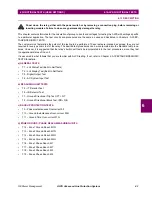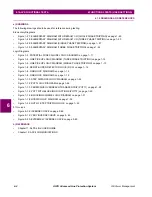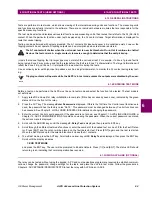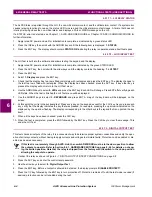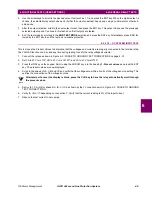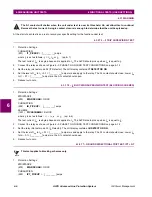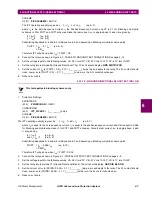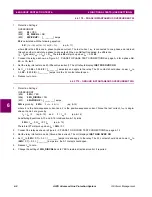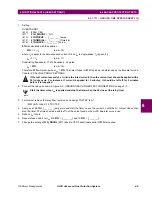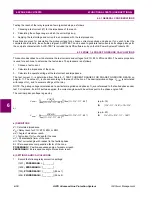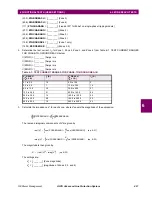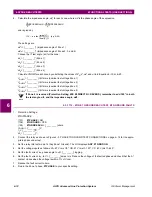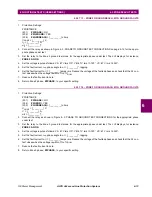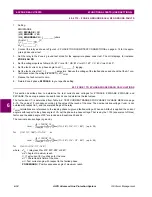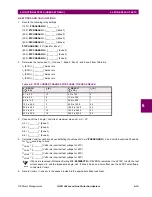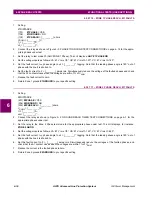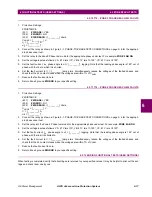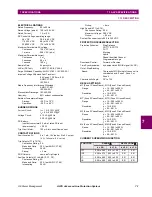
6-4
ALPS Advanced Line Protection System
GE Power Management
6.2 GENERAL RELAY TESTS
6 FUNCTIONAL TESTS (USER SETTINGS)
6
6.2 GENERAL RELAY TESTS
6.2.1 T1 – LUI RELAY STATUS
The ALPS Status is reported through the LUI, the non-critical alarm contact, and the critical alarm contact. If a system error
causes relaying functions to cease, the status LED turns red and the critical alarm contact closes. A failure that does not
interrupt relaying closes the non-critical alarm and displays a FAIL or WARN message on the LUI.
If a STATUS error is detected, see Chapter 11: ALPS-LINK USER GUIDE or Chapter 12: ASCII COMMUNICATIONS for
further information.
1.
Apply rated DC power and wait for initialization to complete, as indicated by a green status LED.
2.
Press the INF key, then scroll with the ARROW keys until the following item is displayed: 1. STATUS
3.
Press the ENT key. The display should contain STATUS OK indicating the relay is operational and all self-tests pass.
6.2.2 T2 – LUI DISPLAY TEST
The LUI Test is built into the software and allows testing the keypad and the display.
1.
Apply rated DC power and wait for initialization to complete, indicated by the green STATUS LED.
2.
Press the ACT key, then scroll with the arrow keys until the display contains the heading: 7. LUI TEST
3.
Press the ENT key.
4.
Select 1. Display and press the ENT key.
5.
Check that the display has two rows filled completely with rectangles and press the ENT key. The display changes to
the last two rows filled with rectangles. When the display has been checked press the ACT key. If any other key is
pressed the display will not return to the LUI Test menu.
6.
Use the ARROW keys to select 2. LEDs and press the ENT key. Each LED will change. Press ENT after verifying each
LED state. When the test is finished the LUI Test menu will be displayed.
7.
Use the ARROW keys to select 3. KEYBOARD and press ENT. A map of the key board will be displayed on the
screen.
8.
At this point the LUI is in the keyboard test. Press every key on the keypad, except for the CLR key. As you press each
key, verify that the display indicates the key that was pressed. For example, pressing the up arrow is indicated on the
displayed by the up arrow flashing. The display corresponding to the other keys is the legend that is on printed the key
itself.
9.
When all the keys have been checked, press the CLR key.
10. When the test is completed, press the END followed by the ENT key. Press the CLR key to clear the message. This
ends the LUI Test.
6.2.3 T3 – DIGITAL OUTPUT TEST
This test checks all outputs of the relay. It is a convenient way to determine proper system connections and verify the oper-
ation of all relay contacts, without having to apply currents and voltages to simulate faults. Protection can be enabled or dis-
abled, as deemed necessary.
If this test is run remotely through ALPS-Link, then switch RM BRKR must be in the down position to allow
the outputs to operate. Refer to Section 8.4.1: HARDWARE SWITCHES on page 8–24 for details on chang-
ing the switch position. Note that the relay is shipped from the factory with the switch in the down position
allowing the outputs to operate.
1.
Connect the relay as shown in Figure 4–1: DIGITAL OUTPUTS TEST CONNECTIONS on page 4–9.
2.
Press the ACT key and enter the control level password.
3.
Use the arrow keys to select: 8. Digital Output Test
4.
Press the ENT key. Before a contact is allowed to be tested, the display prompts: DISABLE PROTECT?
5.
Press the 1/Y key followed by the ENT key to turn protection off. Protection remains off until the test mode is ended (if
desired, protection can be left enabled during the test).
NOTE












